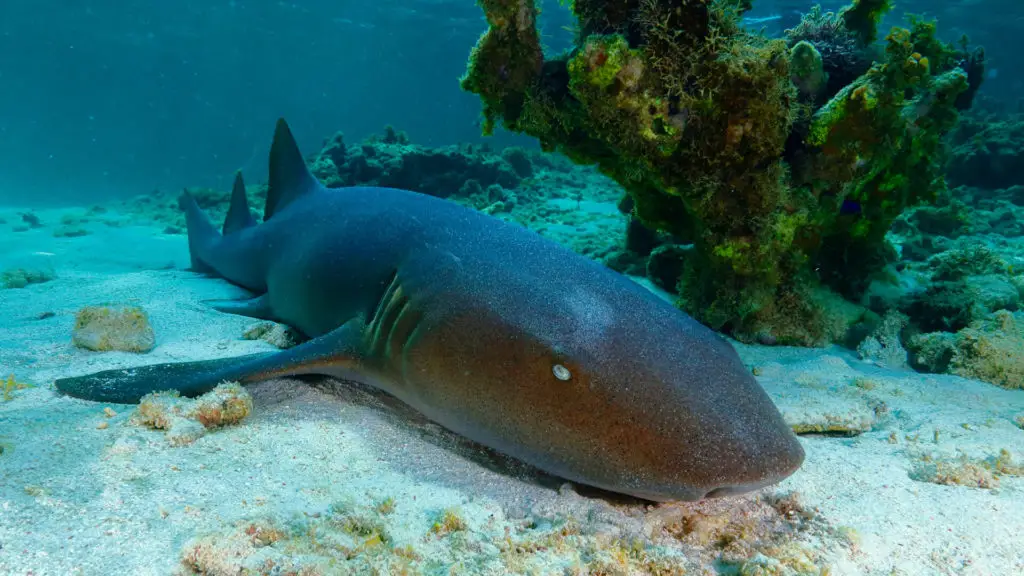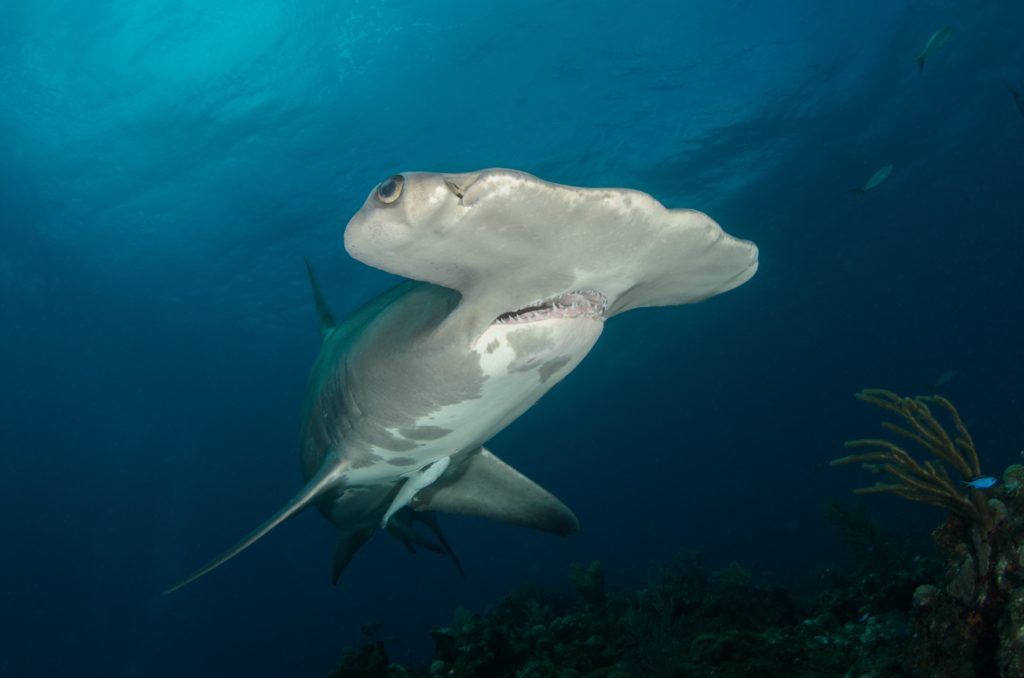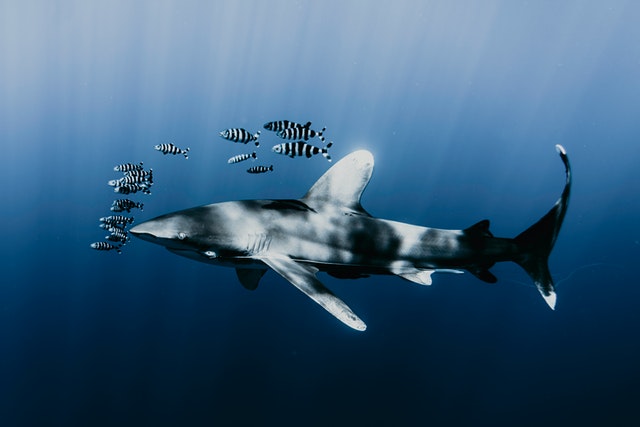A common question we hear from many of our readers, especially those planning their sunny getaways, is: “Are there sharks along the beaches of the Florida Panhandle?”.
It’s a valid concern for anyone dipping their toes into the vast ocean. In this post, we’ll dive into this topic, providing you with not just answers, but also peace of mind.
So, sit back, relax, and let’s explore the reality of our finned friends in these beautiful waters.
Dont have time? Yes, there are sharks along the beaches of the Florida Panhandle, but they are generally not a threat to swimmers. The warm Gulf waters are home to a variety of shark species, such as blacktip, spinner, and sandbar sharks, which usually stay farther out in deeper waters. Shark sightings close to shore are rare, and the chances of encountering an aggressive shark are very low. Local authorities also monitor beach conditions closely, and any increased shark activity is communicated to beachgoers to ensure safety. So while sharks are part of the ecosystem, it’s safe to enjoy the beautiful Panhandle beaches with a little awareness and respect for marine life.
Overview of Sharks in Florida Waters
The waters off the Florida Panhandle are teeming with marine life, including a variety of shark species. It’s important to understand that sharks are a natural and essential part of the ocean’s ecosystem, playing a crucial role in maintaining the health of our seas.
Among the species you might encounter are the nurse shark, known for its docile nature, and the more elusive bull shark, which prefers shallow coastal waters.
Despite their presence, it’s rare for sharks to interact closely with beachgoers. Sharks in the Panhandle region generally keep to themselves, hunting for fish and other marine creatures far from the shore.
The misconception of sharks as menacing predators is often fueled by sensational stories and movies, but the reality in these waters is much more mundane.
The beauty of the Florida Panhandle’s beaches goes hand-in-hand with the natural marine life that inhabits these waters.
Sharks, like all wildlife here, are an integral part of the ecosystem that makes this region so unique and captivating. Understanding and respecting these creatures is key to appreciating the full beauty of our oceanic backyard.
Statistics on Shark Encounters in the Panhandle
When it comes to understanding the likelihood of a shark encounter along the Florida Panhandle, it’s essential to look at the facts.
According to the Florida Museum of Natural History’s International Shark Attack File, the odds of experiencing a shark attack are exceedingly low. In fact, the Panhandle, known for its clear waters and family-friendly beaches, reports very few incidents annually, with the majority being minor and non-fatal.
To put it into perspective, you’re more likely to encounter a shark on television than on one of these beaches. Compared to other coastal regions in Florida, the Panhandle has a significantly lower incidence of shark encounters. This is partly due to the geography and water conditions of the area, which are less conducive to typical shark habitats.
Moreover, the few encounters that have occurred tend to involve surfers or fishermen who venture further into the ocean, beyond the swimming areas.
For the casual beachgoer staying within designated swimming zones, the risk is even lower. It’s important to remember that while these statistics are reassuring, they don’t diminish the need for awareness and respect for marine life.
Types of Sharks on Florida’s Emerald Coast
According to Florida Wildlife Officials, these are the types of you can expect to find along the FL Panhandle are mentioned below:
NURSE SHARK:
These sharks are mostly found at the bottom of the sea. They can be distinguished from the other sharks because of their barbel (whisker-like anatomy), less sharp fins, length of about 14 feet & brownish-bronze color. They are not that harmful until you go ahead & provoke them.

BLACKTIP-SPINNER:
Though these two are different, they are grouped together for their similarities. Both sharks share the same feature of a streamlined body and fins that have a black tip. However, the spinner has more of a noticeable black tip since the anal fin is black-tipped as well. Both sharks can reach lengths of 8 feet and are harmless (unless provoked of course).

HAMMERHEADS:
These are the one that you really need to look out for, as cases of them attacking people without being provoked has been reported. There are about 5 species of them. Their features include a large dorsal fin (the sort you see in movies) & a head that is shaped as an aerofoil. Their aerofoil head helps them in a lot of ways like helping them while swimming, working as sensory cells’ battery & helping them to find buried prey.

BULL SHARK:
These are the ones that you might have seen in the movie Jaws& it wouldn’t be wrong to say that they were rightfully depicted in the movie. These sharks are aggressive in nature & are the ones who mostly attack without any provocations. These sharks are euryhaline (having tolerance for various salinities). This is the reason they are found by people as they could be dwelling within 100 miles of the coast.

THRESHER SHARK:
These sharks have a peculiar look. The majority of the sharks have a heterocercal tail (the upper part of the tail is longer than the lower lobe). The specialty of the Thresher Shark is that their upper lobe is way too large making up about half of their body! They are not seen near the beach as they generally live offshore. There had been no report of attacks from this shark.

WHALE SHARK:
As you already must know, whale sharks are the biggest shark on the planet earth. They are not anything short of magnificent & majestic. The average length of these sharks stands at 45 feet but they can grow up to 60 feet! They have quite a distinct brownish color with white or beige spots running along their dorsal side. During the daytime, it is very rare to get to see them as they dive deeper during that time of the day. They resurface at night time but are sometimes, unfortunately, struck by boats.

TIGER SHARK:
Tiger Sharks have been given their name because when they are young, they have vertical, dark stripes that are found on their body. As they age, these stripes start to fade. One thing about Tiger Shark is that they’ve got some nice pair of teeth that can literally crack a turtle’s shell! These sharks can grow up to 10-14 feet in length and are known to be very dangerous. They are mainly found in sub-tropical and tropical waters.

Which Sharks Along The Florida Panhandle Are a Threat To Humans?
Even though there are various species of sharks present in the Panhandle area, there are only a few of them which are lethal in nature.
Those sharks are mentioned below:
- Tiger Sharks
- Hammerhead Sharks
- Blacktip Sharks
- Bull Sharks
These are the sharks that are mostly mentioned when incidents of shark attacks occur in the Florida Panhandle (even though they are very rare).
The other sharks like Thresher, Whale, and Nurse are mostly harmless.
The Reality of Shark Risks vs. Other Beach Hazards
While shark encounters might dominate headlines, the reality is that there are other beach hazards that pose a higher risk to beachgoers in the Florida Panhandle. Understanding these risks puts the rare nature of shark encounters into perspective.
Firstly, sun exposure is a significant risk. Sunburn and heatstroke are far more common than any marine dangers. It’s essential to use sunscreen, stay hydrated, and seek shade regularly.
Another often-overlooked hazard is rip currents. These strong currents can catch swimmers off guard and pose a serious threat. Always heed warnings about rip currents and understand how to swim out of one should you find yourself caught.
Lastly, jellyfish stings, while usually not severe, are more common than shark bites. Be aware of jellyfish warnings and know the basic first-aid procedures for stings.
In comparison, the risk of a shark encounter is minimal. By taking standard beach safety precautions, you can safely enjoy the beautiful coastline of the Florida Panhandle.
How To Avoid A Shark Attack
As the saying goes, “Prevention is always better than cure”, in this part of the article, the ways to prevent a shark attack are mentioned below.
You need to get a good idea of the places where the danger is more prominent (i.e., the places where the sharks are most commonly seen & avoid them at any cost). These include:
- Murky water
- Places far away from the shore
- Deepwater where the sharks live (boat channel close to a marina)
- Water having current (passes or inlets)
- Areas with close proximity to fishes that usually are the food of sharks, like mullet or menhaden. These fishes are sometimes found swimming parallel to the shore in the same direction near the beaches.
- It is best to avoid water if you are on your periods or somehow bleeding. Sharks have a strong sense of smell & could probably sense your blood. This could lead to dangerous situations.
- Don’t have shiny objects like jewelry or wear bright contrast colors. These things could attract a shark toward you.
- Activities like chumming, fishing & spearfishing attract sharks.
- Fitful movements or swimming could easily catch a shark’s eyes.
- It is best to move away if a shark shows flustered swimming movements along with hump-backed posture, and pectoral fins that are lowered & raised snout. These all are signs of aggressiveness in a shark.
- It is best to avoid swimming during the night-time, at dusk & dawn, as these are the times when sharks are actively hunting for prey to feed upon.
- People who are isolated are mostly preyed upon by the sharks. It is best to swim in a crowded place.
What To Do If You Are Attacked By A Shark in Florida
Sharks are not the attacking type, so, it is a very rare case when they actually do attack people.
Still, for peace of mind, it is always best to know some safety tips beforehand, in case, you end up in grave danger. Some of these safety tips are as follows:
- The key is to stay calm in such situations. Most of the time, sharks are just curious about you & after getting a good look, move along their path. But if you end up panicking & thrashing around in the water, chances are they’ll think of you as prey that is wounded & try to attack you.
- Don’t even think of taking your eyes off of the shark. As mentioned before sharks are just curious when they see something new in their habitat. If they see that you are alert, soon enough they’ll lose interest & move along their way.
- When you look out for the shark, prepare yourself to fight it just in case. Of course, there is not much you can do when a shark is dead set on eating you but sometimes aiming for their weak spots like eyes, gills & nose helps a lot. It might help you to get released or make the shark change the way of its course.
Types of Shark Attacks
When you encounter a shark & sense that it is going to attack you, you need to have a plan about how you are going to defend yourself.
To develop the plan, you need to understand the moves of the shark accordingly.
There are mainly three types of shark attacks, which are mentioned below:
- HIT-&-RUN ATTACK: In this attack, the shark will bite you one time and then runs off. It is speculated by the experts that this attack is unintentional on the shark’s part as they mistake the human as their prey.
- BUMP-&-BITE ATTACK: In this attack, it could be said that the shark provides a sort of warning to the victim before actually attacking them. At first, the shark will bump them & then return to attack them.
- SNEAK ATTACK: This is the most lethal & scary attack among the others. As the name suggests, there is no warning about this type of attack. The shark sneaks up on you and attacks suddenly. You don’t get any time to process what happened. Unlike the it-&-Run’, here the shark doesn’t stop at one bite but instead attacks the victim continuously.
What To Do If You Encounter A Shark Attack
You need to get your wounds treated as soon as possible. There are basically three steps that need to be taken if you are attacked or bitten by a shark:
- STEP 1: (FIRST AID AT HOME): It is advised that as soon as the victim is brought to safety, they should be provided with warmth to warm them as they might be feeling cold from the water. Any visible wound should be controlled by the application of direct pressure. The hospital should be contacted as soon as possible. It is also mandatory that all the major or minor wounds are washed thoroughly with water & soap. The wounds should be covered with clean gauze, so as to avoid any kind of infection.
- STEP 2: (MEDICAL HELP): A doctor must check all the wounds to make sure nothing is serious. Most of the time shark attack victims die from a huge blood loss, so, it is very necessary that the bleeding is stopped immediately. IV fluids & blood products might be needed if the injuries are grave.
If the condition is very critical then the patient might need to be admitted to the operating room where the doctor will remove the dead tissues, debris, or any tooth fragments that are still left behind in the wound.
The wounds will be stitched loosely to prevent any infection. The doctor then will prescribe some antibiotics and a tetanus booster as a further precaution from infections.
- STEP 3: (FOLLOW-UP): It is necessary that the bite wound is closely monitored since it might show signs of infection. As seawater is filled with various bacteria that are not found on land, it might need special antibiotics prescribed by the doctor. It is advised that a follow-up visit should be scheduled if the condition of the wound worsens with time. The signs that would need a doctor’s visit are discharge, swelling, increasing pain, fever, blister, or red-streaking around the wound.
Final Word On FL Panhandle Sharks
From the above article, we can draw the conclusion that even though there are dangerous SHARKS ALONG THE FLORIDA PANHANDLE, incidents of a shark attack are very rare (only 3164 attacks from unprovoked sharks were recorded since the late 1500s).
So, if you are in the mood for some sea surfing & sunbathing, you do not need to worry about any sharks attacking you.
You can feel free to enjoy your vacations as you want. Just pack your luggage and head to any of the top beaches of the Florida Panhandle like PENSACOLA BEACH, NAVARRE BEACH, DESTIN AND CRAB ISLAND, or SANTA ROSA!
But, of course, it should be mentioned that it is not absolutely necessary for you to get in the sea if you are really uncomfortable doing so.
At the end of the day, it is all about you & your enjoyment. You can enjoy your vacation on land as much as the others can enjoy theirs at sea!

